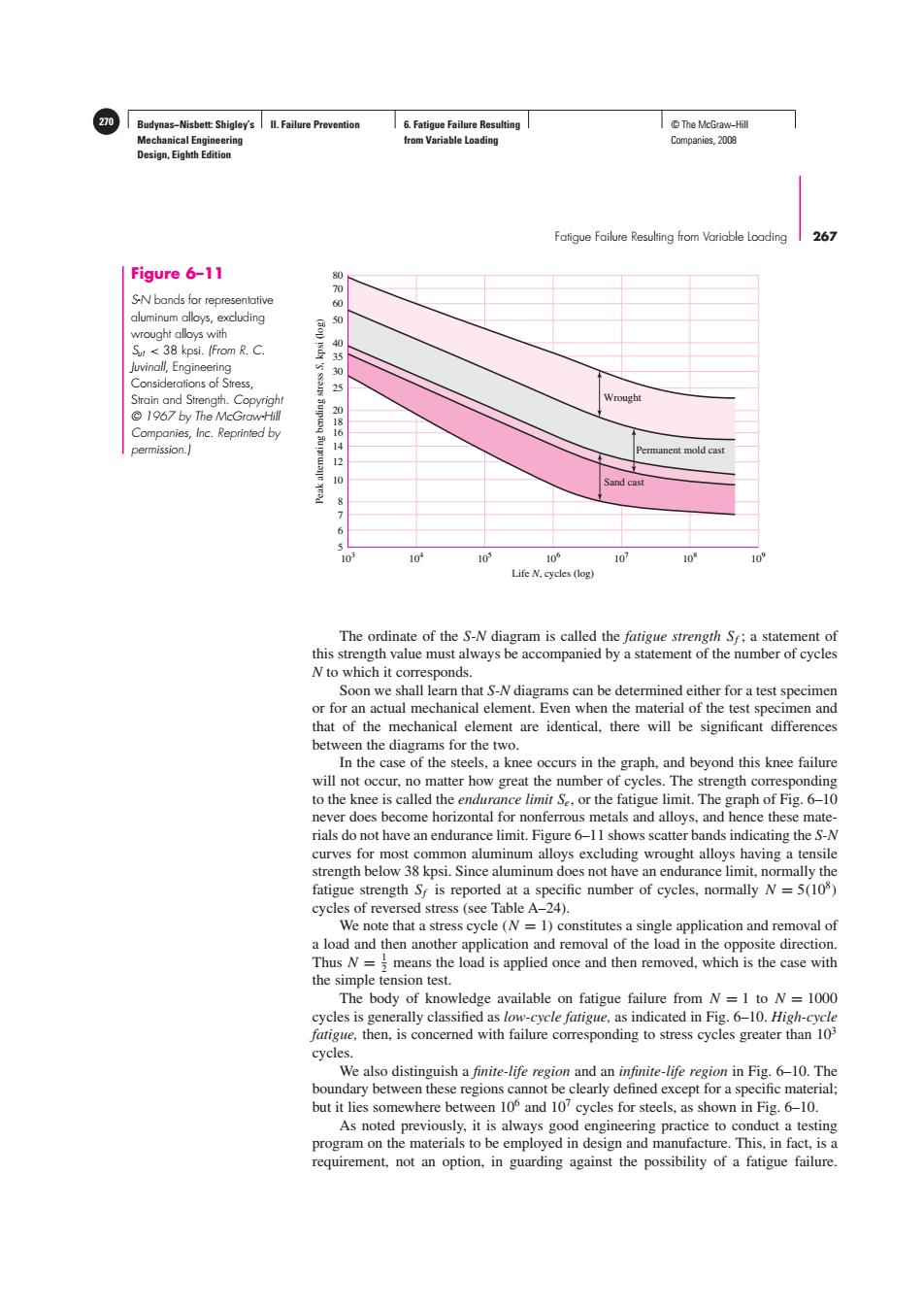正在加载图片...

270 Budynas-Nisbett:Shigley's ll.Failure Prevention 6.Fatigue Failure Resulting ©The McGraw-Hill Mechanical Engineering from Variable Loading Companies,2008 Design,Eighth Edition Fatigue Failure Resulting from Variable Loading 267 Figure 6-11 80 SN bands for representative aluminum alloys,excluding wrought alloys with Sut <38 kpsi.(From R.C. luvinall,Engineering 吃 Considerations of Stress, Strain and Strength.Copyright Wrought 1967 by The McGraw-Hill Companies,Inc.Reprinted by 16 permission.] rmanent mold cast 12 10 Sand cast 8 6 103 10 10° 10* Life N,cycles (log) The ordinate of the S-N diagram is called the farigue strength Sf:a statement of this strength value must always be accompanied by a statement of the number of cycles N to which it corresponds. Soon we shall learn that S-N diagrams can be determined either for a test specimen or for an actual mechanical element.Even when the material of the test specimen and that of the mechanical element are identical,there will be significant differences between the diagrams for the two. In the case of the steels,a knee occurs in the graph,and beyond this knee failure will not occur,no matter how great the number of cycles.The strength corresponding to the knee is called the endurance limit Se,or the fatigue limit.The graph of Fig.6-10 never does become horizontal for nonferrous metals and alloys,and hence these mate- rials do not have an endurance limit.Figure 6-11 shows scatter bands indicating the S-N curves for most common aluminum alloys excluding wrought alloys having a tensile strength below 38 kpsi.Since aluminum does not have an endurance limit,normally the fatigue strength Sf is reported at a specific number of cycles,normally N=5(108) cycles of reversed stress (see Table A-24). We note that a stress cycle(N=1)constitutes a single application and removal of a load and then another application and removal of the load in the opposite direction. Thus N =means the load is applied once and then removed,which is the case with the simple tension test. The body of knowledge available on fatigue failure from N=1 to N=1000 cycles is generally classified as low-cycle fatigue,as indicated in Fig.6-10.High-cycle fatigue,then,is concerned with failure corresponding to stress cycles greater than 103 cycles. We also distinguish a finite-life region and an infinite-life region in Fig.6-10.The boundary between these regions cannot be clearly defined except for a specific material: but it lies somewhere between 10 and 10'cycles for steels,as shown in Fig.6-10. As noted previously,it is always good engineering practice to conduct a testing program on the materials to be employed in design and manufacture.This,in fact,is a requirement,not an option,in guarding against the possibility of a fatigue failure.Budynas−Nisbett: Shigley’s Mechanical Engineering Design, Eighth Edition II. Failure Prevention 6. Fatigue Failure Resulting from Variable Loading 270 © The McGraw−Hill Companies, 2008 Fatigue Failure Resulting from Variable Loading 267 80 70 60 50 40 35 30 25 20 18 16 14 12 10 8 7 6 5 103 104 105 106 107 108 109 Life N, cycles (log) Peak alternating bending stress S, kpsi (log) Sand cast Permanent mold cast Wrought Figure 6–11 S-N bands for representative aluminum alloys, excluding wrought alloys with Sut < 38 kpsi. (From R. C. Juvinall, Engineering Considerations of Stress, Strain and Strength. Copyright © 1967 by The McGraw-Hill Companies, Inc. Reprinted by permission.) The ordinate of the S-N diagram is called the fatigue strength Sf ; a statement of this strength value must always be accompanied by a statement of the number of cycles N to which it corresponds. Soon we shall learn that S-N diagrams can be determined either for a test specimen or for an actual mechanical element. Even when the material of the test specimen and that of the mechanical element are identical, there will be significant differences between the diagrams for the two. In the case of the steels, a knee occurs in the graph, and beyond this knee failure will not occur, no matter how great the number of cycles. The strength corresponding to the knee is called the endurance limit Se, or the fatigue limit. The graph of Fig. 6–10 never does become horizontal for nonferrous metals and alloys, and hence these materials do not have an endurance limit. Figure 6–11 shows scatter bands indicating the S-N curves for most common aluminum alloys excluding wrought alloys having a tensile strength below 38 kpsi. Since aluminum does not have an endurance limit, normally the fatigue strength Sf is reported at a specific number of cycles, normally N = 5(108) cycles of reversed stress (see Table A–24). We note that a stress cycle (N = 1) constitutes a single application and removal of a load and then another application and removal of the load in the opposite direction. Thus N = 1 2 means the load is applied once and then removed, which is the case with the simple tension test. The body of knowledge available on fatigue failure from N = 1 to N = 1000 cycles is generally classified as low-cycle fatigue, as indicated in Fig. 6–10. High-cycle fatigue, then, is concerned with failure corresponding to stress cycles greater than 103 cycles. We also distinguish a finite-life region and an infinite-life region in Fig. 6–10. The boundary between these regions cannot be clearly defined except for a specific material; but it lies somewhere between 106 and 107 cycles for steels, as shown in Fig. 6–10. As noted previously, it is always good engineering practice to conduct a testing program on the materials to be employed in design and manufacture. This, in fact, is a requirement, not an option, in guarding against the possibility of a fatigue failure